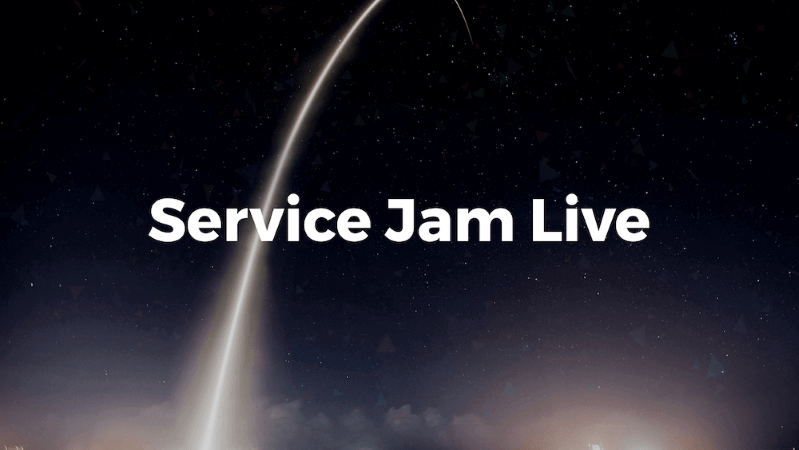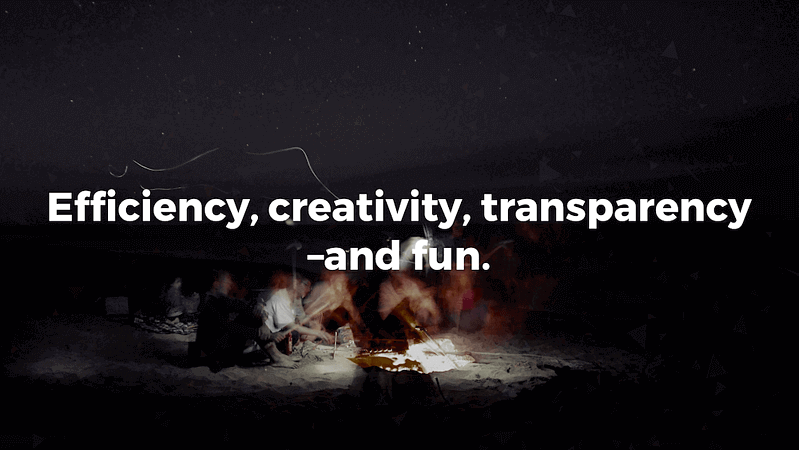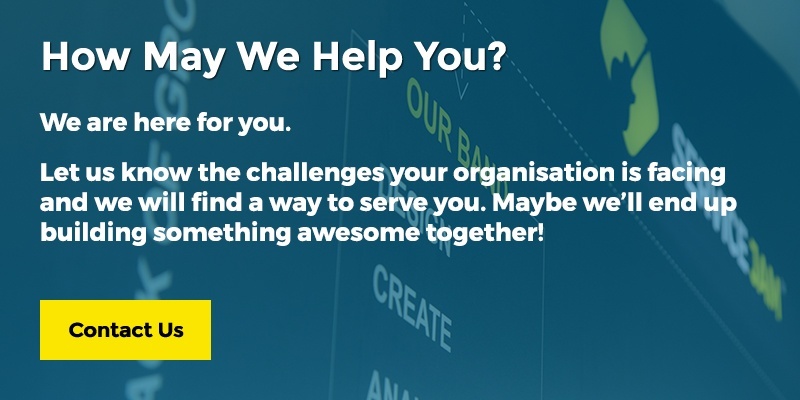Five-Four-Three-Two-1… And we’re LIVE!

This is about 0-day delivery capability with a design to delight.
No more endless debate-cycles and slow, time consuming decision-making processes. This is about 0-day delivery capability with a design to delight.
Service Jam Live
Moving from a world of crystalizing visions and drawing static mockups to combining co-creation, expertise, experience, tools & techniques for 0-day production readiness. No more endless debate-cycles and slow, time consuming decision-making processes. This is about 0-day delivery capability with a design to delight.
So, Let’s Jam... What is a Design Sprint?
The sprint is a five-day process that answers critical business questions through design, prototyping, and testing ideas with customers.
GV design partner Jake Knapp began running design sprints at Google in 2010. He worked with teams like Chrome, Google Search, and Google X. In 2012, Jake brought sprints to GV, and the rest of the team chipped in their expertise to perfect the process.
Braden Kowitz added story-centered design, an unconventional approach that focuses on the customer journey instead of individual features or technologies. Michael Margolis took customer research, which can typically take weeks to plan and often delivers confusing results, and figured out a way to get crystal clear results in just a day.
John Zeratsky helped Design Sprint to start at the end and focus on measuring results with the key metrics from each business. Daniel Burka on the other hand, brought first hand expertise as an entrepreneur to ensure every step was thought out and made sense.
Working together in a sprint, you can shortcut the endless-debate cycle and compress months of time into a single week. Instead of waiting to launch a minimal product to understand if an idea is proficient, you’ll get clear first hand data from a realistic prototype.
The sprint gives you a superpower: You can fast-forward into the future to see your finished product and customer reactions, before making any expensive commitments.
Essentially, on Monday at the start, you’ll map out the problem and pick an eminent area to focus on. On Tuesday, you’ll sketch competing solutions on paper. On Wednesday, you’ll make difficult decisions and turn your ideas into a testable hypothesis. On Thursday, you’ll hammer out a high-fidelity prototype. Lastly, on Friday you’ll test the prototype with real live humans.
For everything, for everyone?
The beauty of the Design Sprint process is in its problem-focused mindset.
For example, we were given a challenge by being asked how to increase the awareness of the importance of the circular economy for primary school students at a recent jam session. The client further asked us, that when you work with Eficode, is the solution habitually digital, as it’s what Eficode does? I answered this question negatively. The beauty here is that it could turn out to be a deck of cards as a game, or it could turn out to be a AR game on iPad. No one knows yet, but let’s find out.

The Design Sprints already started operating in 2010. Hence, it has been in business for seven years, which is a long time in today's constantly changing and developing environment. Today, the Design Sprint works almost for everything. It is a process that is repeatable and teachable, and is in that sense universal and for everyone.
There’s always room for improvement
The world of technological innovations, modern development tools, increasing knowledge of digital product lifecycles, understanding of empathy for design, and the right level of automation have brought us to a place where speed and efficiency matter the most.
When we understood that the structure of the process is right and that it sharply tackles a major issue in business, educated decision making, we thought this works as a great baseline for our Service Jam Lives. However, there is more to that.

At Eficode we love to try and challenge ourselves to think what’s new here?
Startups throw mud at the wall and see what sticks, with a 0.002% success rate or less. Whereas, established corporations make more planned, but slower moves. These decisions have around a 12.5% success rate, according to a recent HBR article. This is something we call “The Glue”:
It’s our belief that by combining expertise, experience, and co-creation the point of view for the Session that we start with, isn’t flimsy. It leans on data, domain understanding and veteran viewpoints. We believe the idea won’t completely die, it will just find itself on the right tracks, fine tuning the direction through validation.
So we thought that the time for crystallizing visions is over. It’s time for 0 day production readiness. Why? Because we can.
Together, with two tracks
In reality it’s hard to schedule five sequential days from a busy executives calendar as it should be based on the Design Sprint philosophy, but we don’t think it has to be this way anymore. When you use digital tools you can easily recap what you’ve done and continue where you left off. Therefore, we are able to work with our clients five days a week and the other days work on our own.
Every workshop day is as a decision making day. Every other day is designed for taking the project forward. Every day together as a team.

So what are we talking about here? In conclusion; rounding up the right band, having proper assets, collaboration and knowledge sharing, support efficiency and creativity.
Transparency through automated reporting and a collaborative toolkit.
Fun through all above.
Define what means what: Teach & speak the same lingo
Experience has taught us that one of the biggest issues when building digital products is that we’re in such a new field, evolving so rapidly, that it’s hard to stay up-to-date. New terms are emerging continuously and widely used technologies have their own nicknames etc. There are vague terms, for example, same job might have multiple titles and meanings.
Clearly defining what means what from the get-go and documenting that “dictionary” are some of the key elements to successfully building digital products.
Share the tools of the trade and make them work for you
Team communication (Slack) + collaborative design documentation tools (mural.co, marvel, trello, G suite) + integrations for automated reporting, is an equation that will help your team be more successful. Pile stuff up in trello, have the right fidelity level for information in for example; the lists,cards, and labels and set your team's workflow right.
We use something like Backlog, Todo, In Progress, Ready and Done. This way the whole team can stay up to date with the project development, making the tools work for your team’s favor - And not just informed, but with actionable information the different team members can contribute to the project with.
By having good virtual tools you can have outside contributors take part on your design process. For example, Eficode UX researchers can help with the user interview questions etc. and it could be possible to use focus groups or other ux research methods, enabling the Session team to utilize full range of the services offered by the company.
DECISIONS. Yes, please
The design sprint structure thrives for decision making which is crucial when developing an efficient software. By having short enough direction setting sit downs the team makes sure they stay on the right path. One of the most expensive mistakes in software development is a wrong turn with a major feature development decision.
This decision making supports our co-creation process well. When we work with the client, we push for decisions that gives us guidance for a day further when designing and developing the solutions prototype.
Decisions are also very important in terms of requirements gathering. To be able to come up with a thorough understanding for a proper work estimate, the sooner we start to gain understanding, the better we are able to see the whole picture. This will make the planning of the future easier.
Design with a design system
Google is paving the way on this frontier as well with their Material UI. AirBnB has also depicted well the need for design systems to be able to scale and iterate rapidly based on the constant change in consumer behaviour and needs.
This mindset is crucial for our Service Jam Live. Proper understanding of the design principles, best (next) practices, and common patterns are critical for a successful Session. Having a proven system that refine design assets concerning universal approach will enhance the look and feel as well as speed things up to a needed level.
When you design a system intended for others to design with, you’re thinking about others automatically. Hence, it’s easier to create and structure something with an understandable meaning, making faster to scale up the product with design wise.
Have a library of things that actually work
Complimenting this design system with a library of things that actually work snaps these two together neatly. We write bleeding-edge technology components (right now ReactJS and React Native) that reflect those design assets. You could say all of this is already its own level of automation, for both design and development.
When the tools play nicely for your favor, you have more time for quality conversations that enable informed decision making.
Study, validate, iterate & keep on going
In modern service development you need to understand your users, their needs and wants, and in today’s world their emotions as well. Thus, you study how your users behave with the intended solution, or the prototype of it.
You can try to find patterns from your feedback to validate your assumptions by asking the right questions from enough people. Then you iterate the proposed solutions approach based on that feedback.
What you do next might matter to a great scale.
Published:
Updated:


